Monopolistic competition is a market structure where many sellers offer similar but slightly different products. Each firm tries to stand out through product differentiation in monopolistic competition—like unique design, branding, or service. Key features include many competitors, easy entry and exit, and some control over pricing.
Common examples include restaurants, clothing brands, and cosmetic companies. Success in this market relies on making products more appealing through features, quality, branding, and customer service, helping businesses attract loyal customers and set higher prices.
What is Product Differentiation?
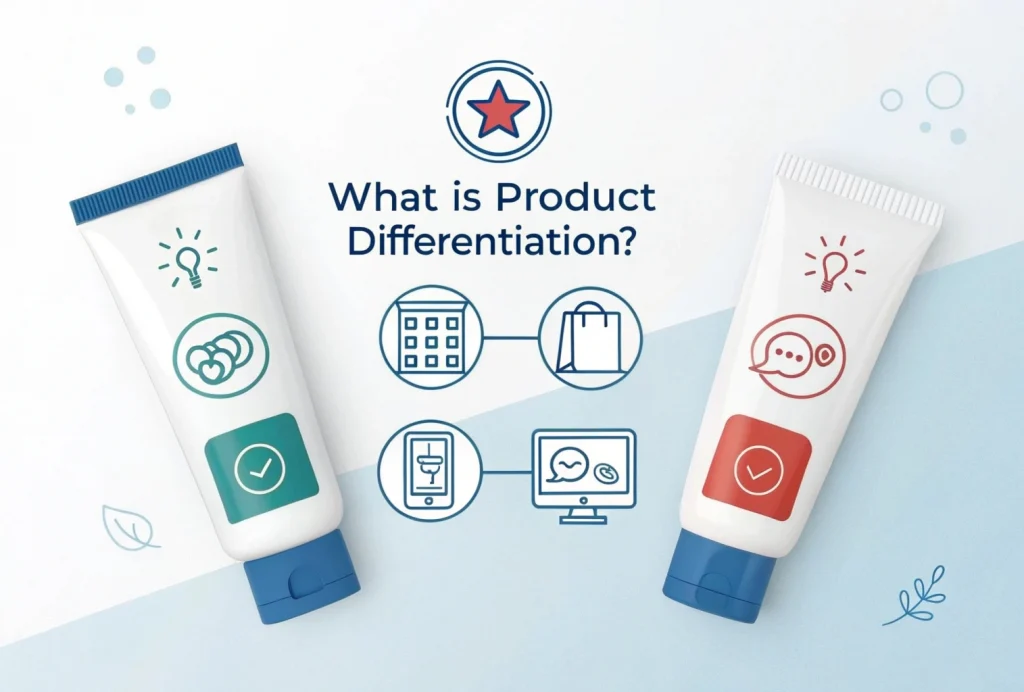
Meaning and Importance
Product differentiation means making a product look or feel different from similar products offered by competitors. The product may serve the same basic purpose, but it has unique features that make it stand out in the eyes of the customer.
For example, two brands of toothpaste may clean your teeth, but one may be known for its whitening power, while the other focuses on natural ingredients.
Why is it important?
- Attracts Customers: A unique product can catch attention and draw more buyers.
- Builds Brand Loyalty: Customers often stick to a brand they like and trust.
- Reduces Price Competition: If your product is unique, people may pay more for it.
- Gives a Competitive Edge: It helps businesses compete without just lowering prices.
Types of Product Differentiation
There are three main types of product differentiation:
- Physical Differentiation
- Based on actual features like design, size, color, flavor, or technology.
- Example: Smartphones with different camera qualities or screen sizes.
- Based on actual features like design, size, color, flavor, or technology.
- Service Differentiation
- Based on how the product is delivered or supported.
- Example: A hotel offering 24/7 room service or a clothing brand offering free returns.
- Based on how the product is delivered or supported.
- Image or Brand Differentiation
- Based on the brand’s image, reputation, or emotional appeal.
- Example: A luxury watch brand that sells status and style, not just timekeeping.
- Based on the brand’s image, reputation, or emotional appeal.
Types of Product Differentiation in Monopolistic Competition
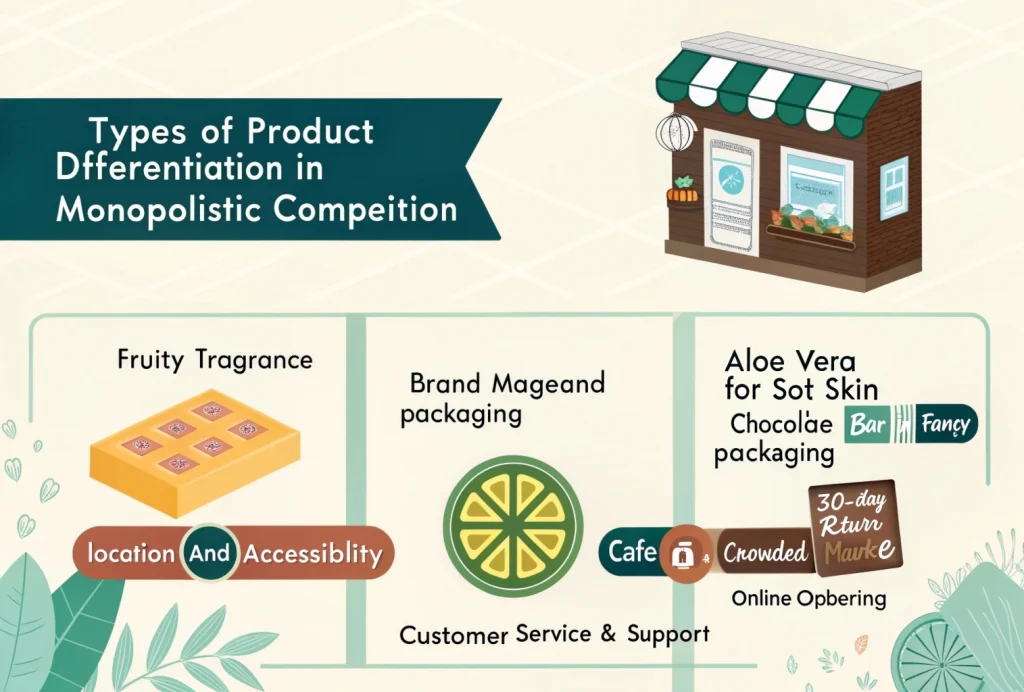
In monopolistic competition, businesses try to stand out by making their products slightly different from others. Here are the main ways they do this:
- Physical Product Differences
This type of differentiation is based on the actual features of the product.
- It includes changes in design, color, size, taste, or quality.
- For example, two types of soap may both clean your skin, but one might have a fruity fragrance, while the other has aloe vera for softening skin.
Why it matters:
Customers choose based on what features they like most.
- Brand Image and Packaging
Branding creates an emotional connection with customers. Packaging adds to the product’s appeal.
- A strong brand name can make a product feel more trustworthy or premium.
- Attractive packaging can grab attention and influence buying decisions.
Example:
A simple chocolate bar in a fancy box may sell better than the same chocolate in plain wrapping.
- Location and Accessibility
Where a business is located and how easy it is to reach also makes a difference.
- A café in a busy market will attract more walk-in customers than one in a faraway street.
- Businesses that offer online ordering or home delivery are often preferred for convenience.
Why it matters:
Customers often choose what’s easiest and most accessible.
- Customer Service and After-Sales Support
Good service builds trust and brings customers back.
- Friendly staff, quick responses, and helpful support make a big impact.
- After-sales services like warranties, repairs, or return policies add extra value.
Example:
Two electronics stores may sell the same product, but the one with better return policies may get more customers.
Why Firms Use Product Differentiation
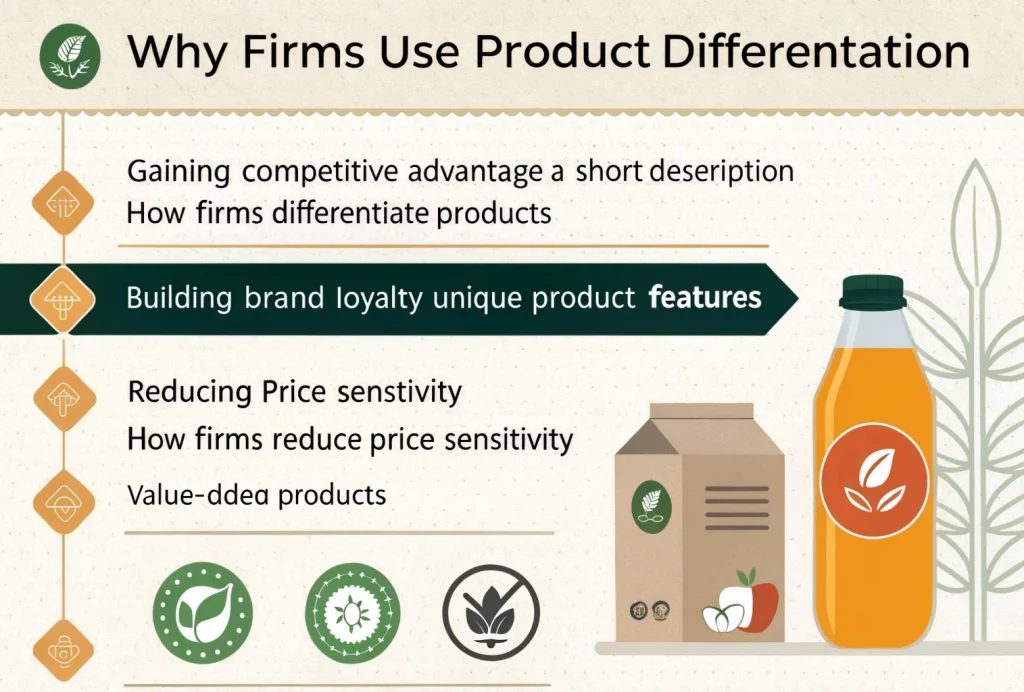
In monopolistic competition, many businesses sell similar products. So, how do they attract more customers? The answer is product differentiation—making their product feel unique or better than others.
Here’s why firms do it:
Benefits of Product Differentiation
| Benefit | Description | Example |
|---|---|---|
| Gaining Competitive Advantage | A unique feature, better quality, or eye-catching design helps a product stand out in the market. | A juice brand with added vitamins or eco-friendly packaging may attract more buyers. |
| Building Brand Loyalty | When customers trust and enjoy a brand, they tend to buy from it repeatedly, building long-term loyalty. | A person may keep buying their favorite coffee brand even if others are cheaper. |
| Reducing Price Sensitivity | If a product is seen as special, customers are willing to pay more and care less about price. | People often pay more for branded shoes because they value the style and trust the quality. |
Examples of Product Differentiation in Real Markets
Now lets look at how real businesses in different industries use product differentiation to stand out and attract customers.
Examples of Product Differentiation in Real Markets
| Industry | Differentiation Strategies | Example |
|---|---|---|
| FMCG (Fast-Moving Consumer Goods) |
|
Coca-Cola offers Coke, Diet Coke, Coke Zero, and flavored versions—each targeting different audiences. |
| Restaurant Chains |
|
McDonald’s focuses on burgers and fries, while Subway offers fresh, customizable sandwiches. |
| Clothing Brands |
|
Zara is known for trendy fashion at reasonable prices; Levi’s is known for durable, iconic denim jeans. |
Impact of Product Differentiation on Consumer Choice
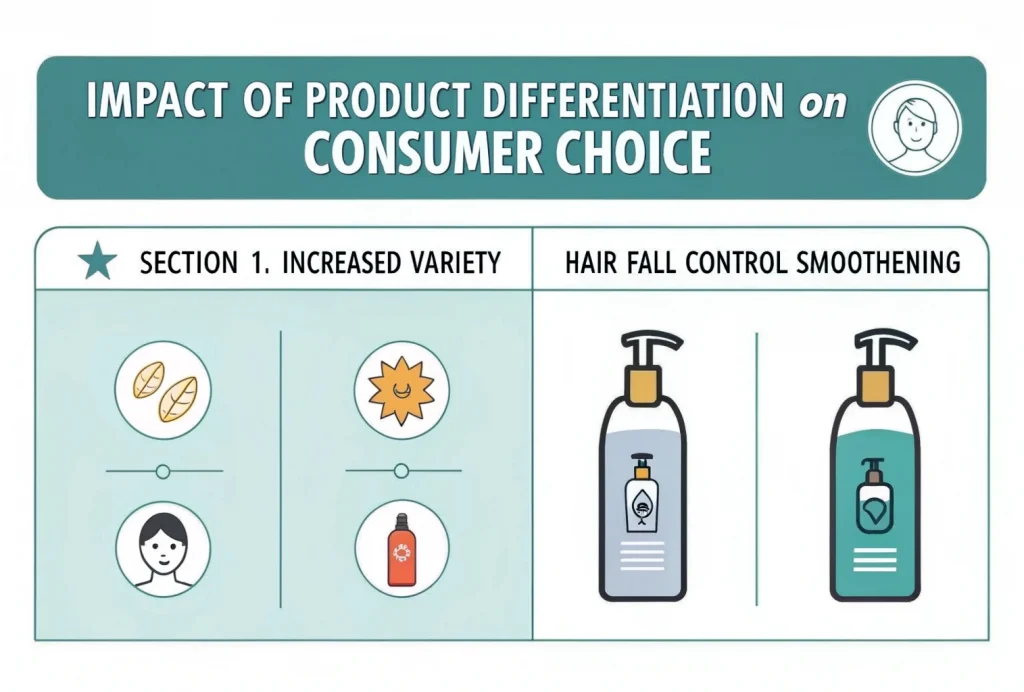
Product differentiation plays a big role in how consumers decide what to buy. It gives them more options and helps them find products that match their needs and tastes.
- Increased Variety
When businesses create slightly different versions of a product, consumers get more choices.
- This variety means people can pick what suits them best in terms of flavor, design, size, price, or features.
- It allows each person to find something that matches their lifestyle or preferences.
Example:
A shampoo brand may offer anti-dandruff, hair fall control, and smoothening variants—so customers choose based on their hair needs.
- Perceived Value and Preferences
Product differentiation affects how people see the value of a product.
- A well-packaged, stylishly branded, or feature-rich product may feel more valuable, even if it serves the same basic purpose as a simpler one.
- People often choose products based on personal likes—like taste, smell, appearance, or the brand’s image.
Example:
Some people prefer branded water bottles over generic ones, even though both may be clean—just because of trust in the brand.
Explore our online programs to become future-ready
Transform your career with industry-aligned courses designed by experts.
Short-Run and Long-Run Effects in Monopolistic Competition
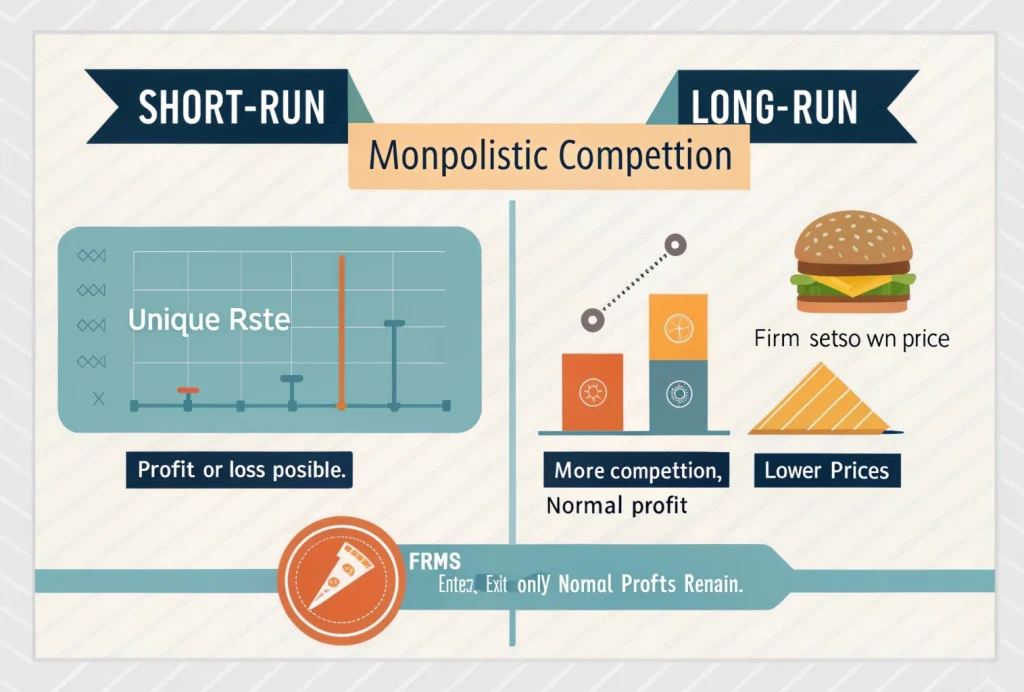
In monopolistic competition, the market behaves differently in the short run and the long run. Let’s understand how price, output, and the number of firms change over time.
- Price and Output Decisions (Short Run)
In the short run, firms can set their own prices because of product differentiation.
- Each firm faces its own demand curve, so it has some control over pricing.
- A firm may earn profits, losses, or break even, depending on how well it attracts customers.
- Firms choose the level of output (quantity) that helps them maximize profits.
Example:
If a new burger joint opens with a unique taste, it can charge a higher price and earn good profits—for a while.
- Entry and Exit of Firms (Long Run)
In the long run, things change as more firms enter or leave the market based on profits.
- If firms are earning profits, new competitors enter with similar but differentiated products.
- This increases competition and reduces profits for everyone.
- If firms are making losses, some will exit the market.
- Eventually, most firms reach a point where they earn normal profits (no extra profit, but enough to stay in business).
Result:
In the long run, prices fall slightly, and firms produce less than they could (called excess capacity), but customers enjoy a wide variety of products.
Challenges of Product Differentiation
While product differentiation helps businesses stand out, it also comes with some difficulties. Let’s look at the main challenges companies face when trying to make their products unique.
Challenges of Product Differentiation
| Challenge | Description | Example / Impact |
|---|---|---|
| High Marketing Costs | To make a product stand out, businesses invest in advertising, branding, and packaging. These efforts can be costly, especially for smaller companies. | Small businesses may lack the budget to effectively promote their unique features compared to big brands. |
| Risk of Imitation | Even unique products can be copied quickly by competitors, reducing their originality and sparking a price war. | A coffee shop’s signature drink could be copied by nearby shops, making it less special and forcing them to compete on price. |
| Consumer Confusion | With too many similar products, customers may not recognize the difference. Slight design changes or messaging may not be enough. | When differences aren’t clear, buyers might simply choose the cheapest option, ignoring value-added features. |
Result:
This reduces the value of product differentiation and makes it harder to build customer loyalty.
Strategies to Improve Product Differentiation
To stand out in a competitive market, businesses need smart strategies to make their products look and feel different. Here are three effective ways to improve product differentiation:
- Innovation and R&D (Research and Development)
Innovation means creating new ideas, designs, or features that improve the product.
- Companies invest in research to understand what customers want.
- They develop new versions of products with better technology, style, or usability.
Example:
Smartphones are updated regularly with better cameras, faster processors, or unique designs to stay ahead of the competition.
Why it helps:
Innovative products attract more attention and offer something fresh that competitors may not have.
- Branding and Advertising
Good branding helps build a strong image for the product, while advertising spreads the message to more people.
- A powerful logo, slogan, or brand story makes the product more memorable.
- Creative ads show what makes the product different and valuable.
Example:
Apple uses sleek ads and simple branding to position its products as premium and user-friendly.
Why it helps:
Branding builds trust, and advertising helps customers understand the unique benefits of the product.
- Quality Improvements
Improving the durability, performance, or finish of a product can make it stand out.
- Customers often return to brands they feel offer better quality.
- Even small upgrades—like stronger materials or smoother textures—can make a difference.
Example:
A clothing brand using organic cotton or double-stitching may win customers who care about quality and sustainability.
Why it helps:
High-quality products build a good reputation and can justify higher prices.
Conclusion
Product differentiation is at the heart of monopolistic competition. Even though many firms sell similar products, each one tries to stand out by adding something unique—whether it’s the design, quality, brand image, or customer experience.
For businesses, product differentiation is a powerful tool to attract customers, build loyalty, and reduce price competition. For consumers, it means more choices and the ability to pick products that match their needs and preferences.
However, creating a unique product comes with challenges like high costs and competition copying your ideas. That’s why businesses need smart strategies like innovation, strong branding, and quality improvements to stay ahead.
In the end, successful product differentiation helps both companies and customers—making markets more exciting, competitive, and full of variety.


Leave a Reply